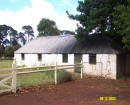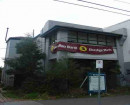BERRY NO.1 MINE
1541 DAYLESFORD-CLUNES ROAD SMEATON, HEPBURN SHIRE
-
Add to tour
You must log in to do that.
-
Share
-
Shortlist place
You must log in to do that.
- Download report
Statement of Significance
The State's richest deep alluvial gold lead system, known as the Berry Lead System, run north from Creswick, slightly to the west of Smeaton. Mining of lead system took place from early 1870s. The Berry No. 1 mine was floated in 1881 and by the end of 1884, the company's main shaft had been sunk 494 feet. Confronted with large flows of water, the company erected some of the most extensive pumping machinery in the State, including a 70-inch cylinder Cornish engine. The engine was locally manufactured at John Hichman's Union Foundry Ballarat and was capable of lifting 60,000 gallons of water per hour. The engine was housed in a brick engine house. The Berry No.1 mine was not one of the field's major gold producers. In fact it was spectacularly unprofitable: in twenty years its record was 50,000 ounces of gold, dividends of less than £5,000, and operating costs of £278,764.
The Berry No.1 Deep Lead Gold Mine is of historical, archaeological and scientific importance to the State of Victoria.
The Berry No.1 Deep Lead Gold Mine is historically and scientifically important as a characteristic example of an important form of gold mining. Gold mining sites are of crucial importance for the pivotal role they have played since 1851 in the development of Victoria. As well as being a significant producer of Victoria's nineteenth century wealth, deep lead mining, with its intensive use of machinery, played an important role in the development of Victorian manufacturing industry. The engine house at the Berry No.1 mine is a crucial reminder of the move by the mining industry from the use of imported Cornish pumping engines to locally produced engines.
The Berry No.1 Deep Lead Gold Mine is scientifically important for its illustration of Cornish pumping technology and building design. The site is archaeologically important for its potential to yield artefacts and evidence which will be able to provide significant information about the technological history of gold mining.
[Source: Victorian Heritage Register]
-
-
BERRY NO.1 MINE - History
Heritage Inventory History of Site: The following history was extracted from The Berry Deep Leads: an historical assessment, CF&L, October 1986, Charles Fahey. The Berry No. 1 mine was floated in March 1881 by William Bailey, Henry Gore, Thomas Dibdin and William Graham. Work on machinery, buildings and shaft sinking commenced shortly after registration. By the end of 1884 the shaft had been sunk 494 feet with no payable results; and at the end of the following year £12,500 had been spent on wages and £14,700 on plant. The Berry No. 1 was confronted with large flows of water and the company erected some of the most extensive machinery on the Berry Leads System. A single acting beam engine was purchased in 1884 from John Hickman's Union Foundry, Ballarat. The beam 32ft long and 6ft wide, was cast in two sections. The cylinder was 70 inches in diameter and weighed 10 tons. In December 1888 this pump lifted 60,000 gallons of water per hour. It was housed in a brick Cornish engine house.In January 1886 all capital was exhausted and the value of the shares lifted from £2 to £4. By the end of the year gold had been found, but a heavy drift had been encountered which had clogged up the company's pumps. The company was reconstructed in June 1889, with the capital being raised to £6 per share, and in September 1890 the mine produced its first gold. Riches did not follow: by September 1893 gold returns had raised £80,728 but declining yields induced the directors to lay off 83 hands. By the following year the gold workings were still not paying expenses and the directors suspended work except for pumping. Advertisements for tributers were called, but all offers were considered 'unworthy'. Work continued with an overdraft, and to add to the company's problems, foul air slowed down output in 1895. The capital was increased to £7 in September 1898. The new capital was exhausted by the turn of the century and the company was wound up. In all the Berry No. 1 produced 50,000 ounces of gold, and dividends of less than £5,000 were paid on calls of £140,000. As of march 1901, the Berry No. 1 had operating costs of £278,764Machinery Information taken from The Significance of some Mining Machinery Sites in the Creswick Division 1859-1927, Technology Report TR-88/1, P. Milner, March 1988 1905 275 horsepower compound condensing steam engine 20 horsepower steam winding engine 25 horsepower steam capstan engine 14 horsepower steam driven air compressor.1906 - To install a second pump; presently discharging 6 million gallons a day 1907 - Main shaft enlarged by 20 feet x 6½ft; 26 inch Cornish pump installed, driven by a geared compound Corliss steam engine and 2 Babcock and Wilcox boilers. 22 inch and 26 inch pumps now capable of lifting 4 million gallons per day; old pump raising one million per day; since October the new pump has been lifting a similar amount. 1908 - First motion steam winding plant and steam puddling plant erected.Significance The ninth gold producer on the Berry Leads, the Berry No. 1 is more important for illustrating the problems frequently encountered with drift. Its engine was one of the major achievements of 19th century Australia engineering. The ruins of the engine house at Berry No. 1 are a crucial reminder of this technological development and the use of Cornish technology and labour.Heritage Inventory Description
BERRY NO.1 MINE - Heritage Inventory Description
Cornish Pump House - Pump house measures 32ft x 25ft and its brick walls survive to a height of approximately 25ft.Shaft/bob pit - Immediately in front of the pump house is a fenced shaft depression and remains of stone bob-pit. To the west of the bob-pit is a long, narrow brick mounting bed.Boiler house site- To the west of the pump house is a spread of rubble, depressions and traces of stone foundations.Mullock heap - Massive heapPebble dump - Adjoining the mullock heap is a massive pebble dump
Heritage Inventory Significance: The site has:Historical significance - company operated some of the most extensive plant on the Creswick fieldScientific significance - ruins of the engine house at Berry No. 1 are a crucial reminder of a particular technologyArchaeological potentialNetwork values - part of the Berry network of significant sitesSIGNIFICANCE RANKING: National Estate
Recorded by: J. Harrington & David Bennear Date Recorded: 00SEP1994
Heritage Inventory Site Features: - pump house - shaft/bob pit- boiler house site- mullock heap- pebble dump
-
-
-
-
-
BERRY NO.1 DEEP LEAD GOLD MINE
 Victorian Heritage Register H1740
Victorian Heritage Register H1740 -
BERRY NO.1 MINE
 Victorian Heritage Inventory
Victorian Heritage Inventory -
BERRY CONSOLS NO.2 MINE
 Victorian Heritage Inventory
Victorian Heritage Inventory
-
-







